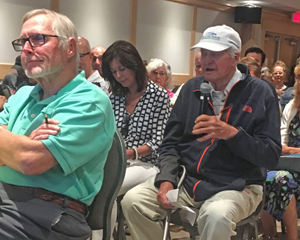 Former Prime Minister John Turner led the call for action from Canada to put a plan in place with Minnesota to protect Lake of the Woods water qualityA vocal, engaged and committed crowd of 200 citizens concerned about toxic and nuisance algae in Lake of the Woods gathered at the Clarion Hotel in Kenora, Aug. 15, 2018 to learn what is being done to address the problem.
Former Prime Minister John Turner led the call for action from Canada to put a plan in place with Minnesota to protect Lake of the Woods water qualityA vocal, engaged and committed crowd of 200 citizens concerned about toxic and nuisance algae in Lake of the Woods gathered at the Clarion Hotel in Kenora, Aug. 15, 2018 to learn what is being done to address the problem.
The public meeting started with an update from the International Joint Commission (IJC) Watershed Board, which was followed by a presentation from the Minnesota Pollution Control Agency about its research and plan to cut phosphorus pollution to Lake of the Woods. Environment and Climate Change Canada (ECCC) followed with a presentation about how Canada could potentially proceed to develop phosphorus targets as well, responding to a recent recommendation from the IJC that Canada immediately adopt interim targets and develop bi-national water quality objectives with Minnesota – essentially an agreement like on the Great Lakes.
Passionate public demands action
Discussion with the audience was lively. The work and recommendations of the IJC Watershed Board were appreciated and Minnesota was commended for its comprehensive research and action plan to cut phosphorus pollution. Some expressed frustration with Canada’s actions and an appetite for more specific information from ECCC about its science underway on the lake.
Many attendees, led by former Prime Minister John Turner, voiced strongly a demand for Canada to “get on with it” and take action immediately to combat algae blooms jointly with Minnesota. Participants urged Canada to commit to more than science studies – to establish water quality objectives and targets for phosphorus and commit to reductions.
A path forward for Canada?
While not committing to targets per se, the presentation from ECCC did present a proposed and welcome path forward towards this, modeled on the process that Canada and the U.S. took to develop water quality objectives and targets on Lake Erie.
There was some unfortunate confusion about this being referred to as “applying the Lake Erie model” to Lake of the Woods. ECCC is not proposing applying a computer model for Lake Erie to Lake of the Woods, nor that they think that the two lakes are similar. The term “Lake Erie model” is government agency slang for the process that Canadian and American governments are already familiar with, most recently applied by both countries to develop agreement on water quality objectives for Lake Erie.
This is the Great Lakes Water Quality Agreement and its Annex 4 that specifically deals with the problems of nutrients and algae blooms. Annex 4 lays out a systematic process to both countries to follow:
- engaging the public to develop lake ecosystem objectives (what we want or expect the lake conditions to be),
- establishing objectives for phosphorus concentrations in the lake to achieve the desired environmental outcomes,
- determining reduction targets needed and how they are allocated to each country,
- developing domestic action plans by each country to meet the phosphorus reduction targets,
The fact that senior officials from ECCC’s policy branch were in Kenora talking publicly about this path forward for Lake of the Woods is a welcome step in the right direction. Many would like to have seen a definite statement of commitment to this. Since the 1970s, our governments have committed to an international water quality agreement for the Great Lakes – Lake of the Woods deserves no less!
The Honourable Bob Nault, Member of Parliament for Kenora, wrapped up the afternoon session. He congratulated Minnesota on the completion of its research and its actions to protect our shared waters on Lake of the Woods. MP Nault commented on the importance of the lake to our shared social and economic wellbeing and as chair of the Foreign Affairs Committee of Parliament, he assured the audience that Canada would cooperate closely with the U.S. on Lake of the Woods. Noting that the Canadian investment in science will be completed by 2020, he assured the audience that there would be a Lake of the Woods specific plan for water quality objectives and actions.
We are grateful to the hundreds of you who love our waters who took the time on a beautiful August afternoon to learn what is being done and to send a message to governments that Lake of the Woods matters and that you care!
